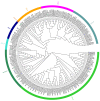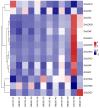Identification of the Maize LEA Gene Family and Its Relationship with Kernel Dehydration
- PMID: 37960031
- PMCID: PMC10647770
- DOI: 10.3390/plants12213674
Identification of the Maize LEA Gene Family and Its Relationship with Kernel Dehydration
Abstract
Maize, the most widely planted and highest yielding of the three major crops in the world, requires the development and breeding of new varieties to accommodate the shift towards mechanized harvesting. However, the moisture content of kernels during harvest poses a significant challenge to mechanized harvesting, leading to seed breakage and increased storage costs. Previous studies highlighted the importance of LEA (Late Embryogenesis Abundant) members in regulating kernel dehydration. In this study, we aimed to gain a better understanding of the relationship between the LEA family and grain dehydration in maize. Through expression pattern analysis of maize, we identified 52 LEA genes (ZmLEAs) distributed across 10 chromosomes, organized into seven subgroups based on phylogenetic analysis, gene structure, and conserved motifs. Evolutionary and selective pressure analysis revealed that the amplification of ZmLEA genes primarily resulted from whole-genome or fragment replication events, with strong purifying selection effects during evolution. Furthermore, the transcriptome data of kernels of two maize inbred lines with varying dehydration rates at different developmental stages showed that 14 ZmLEA genes were expressed differentially in the two inbreds. This suggested that the ZmLEA genes might participate in regulating the kernel dehydration rate (KDR) in maize. Overall, this study enhances our understanding of the ZmLEA family and provides a foundation for further research into its role in regulating genes associated with grain dehydration in maize.
Keywords: ZmLEA; expression pattern; kernel dehydration rate; maize.
Conflict of interest statement
The authors declare that they have no competing financial interest or personal relationships that could have influenced the work reported in this paper.
Figures









Similar articles
-
Reveal the kernel dehydration mechanisms in maize based on proteomic and metabolomic analysis.BMC Plant Biol. 2024 Jan 2;24(1):15. doi: 10.1186/s12870-023-04692-z. BMC Plant Biol. 2024. PMID: 38163910 Free PMC article.
-
QTL mapping and omics analysis to identify genes controlling kernel dehydration in maize.Theor Appl Genet. 2024 Sep 26;137(10):233. doi: 10.1007/s00122-024-04715-9. Theor Appl Genet. 2024. PMID: 39325221
-
Detection of QTNs for kernel moisture concentration and kernel dehydration rate before physiological maturity in maize using multi-locus GWAS.Sci Rep. 2021 Jan 19;11(1):1764. doi: 10.1038/s41598-020-80391-1. Sci Rep. 2021. PMID: 33469070 Free PMC article.
-
Genome-wide identification and characterization of members of the LEA gene family in Panax notoginseng and their transcriptional responses to dehydration of recalcitrant seeds.BMC Genomics. 2023 Mar 17;24(1):126. doi: 10.1186/s12864-023-09229-0. BMC Genomics. 2023. PMID: 36932328 Free PMC article.
-
Maize kernel development.Mol Breed. 2021 Jan 3;41(1):2. doi: 10.1007/s11032-020-01195-9. eCollection 2021 Jan. Mol Breed. 2021. PMID: 37309525 Free PMC article. Review.
Cited by
-
GWAS and Meta-QTL Analysis of Kernel Quality-Related Traits in Maize.Plants (Basel). 2024 Sep 29;13(19):2730. doi: 10.3390/plants13192730. Plants (Basel). 2024. PMID: 39409600 Free PMC article.
-
Genome-Wide Identification, Phylogenetic Evolution, and Abiotic Stress Response Analyses of the Late Embryogenesis Abundant Gene Family in the Alpine Cold-Tolerant Medicinal Notopterygium Species.Int J Mol Sci. 2025 Jan 9;26(2):519. doi: 10.3390/ijms26020519. Int J Mol Sci. 2025. PMID: 39859232 Free PMC article.
-
Transcriptomic insights into grain size development in naked barley (Hordeum vulgare L. var. nudum Hook. f): based on weighted gene co-expression network analysis.PeerJ. 2025 Aug 8;13:e19856. doi: 10.7717/peerj.19856. eCollection 2025. PeerJ. 2025. PMID: 40792006 Free PMC article.
-
A micropeptide regulates seed desiccation.Front Plant Sci. 2025 Mar 26;16:1550190. doi: 10.3389/fpls.2025.1550190. eCollection 2025. Front Plant Sci. 2025. PMID: 40206881 Free PMC article. No abstract available.
References
-
- Xie R.Z., Ming B., Gao S., Wang K.R., Hou P., Li S.K. Current state and suggestions for mechanical harvesting of corn in China. J. Integr. Agric. 2022;21:892–897. doi: 10.1016/S2095-3119(21)63804-2. - DOI
-
- Li L.L., Ming B., Xue J., Gao S., Wang K.R., Xie R.Z., Hou P., Li S.K. Difference in corn kernel moisture content between pre- and post-harvest. J. Integr. Agric. 2021;20:1775–1782. doi: 10.1016/S2095-3119(20)63245-2. - DOI
-
- Chai Z.W., Wang K.R., Guo Y.Q., Xie R.Z., Li L.L., Ming B., Hou P., Liu C.W., Chu Z.D., Zhang W.X., et al. Current status of maize mechanical grain harvesting and its relationship with grain moisture content. Sci. Agric. Sin. 2017;50:2036–2043.
LinkOut - more resources
Full Text Sources

